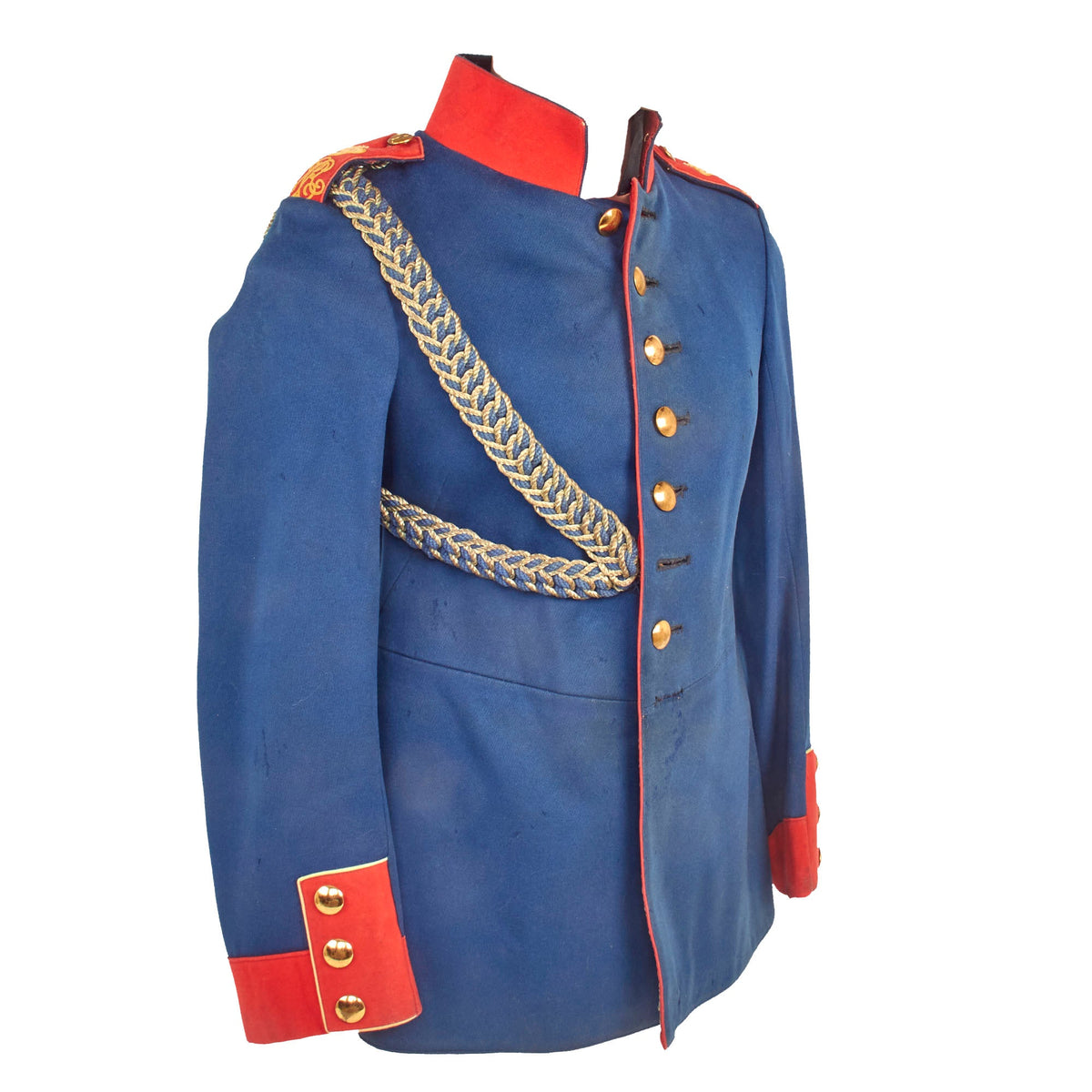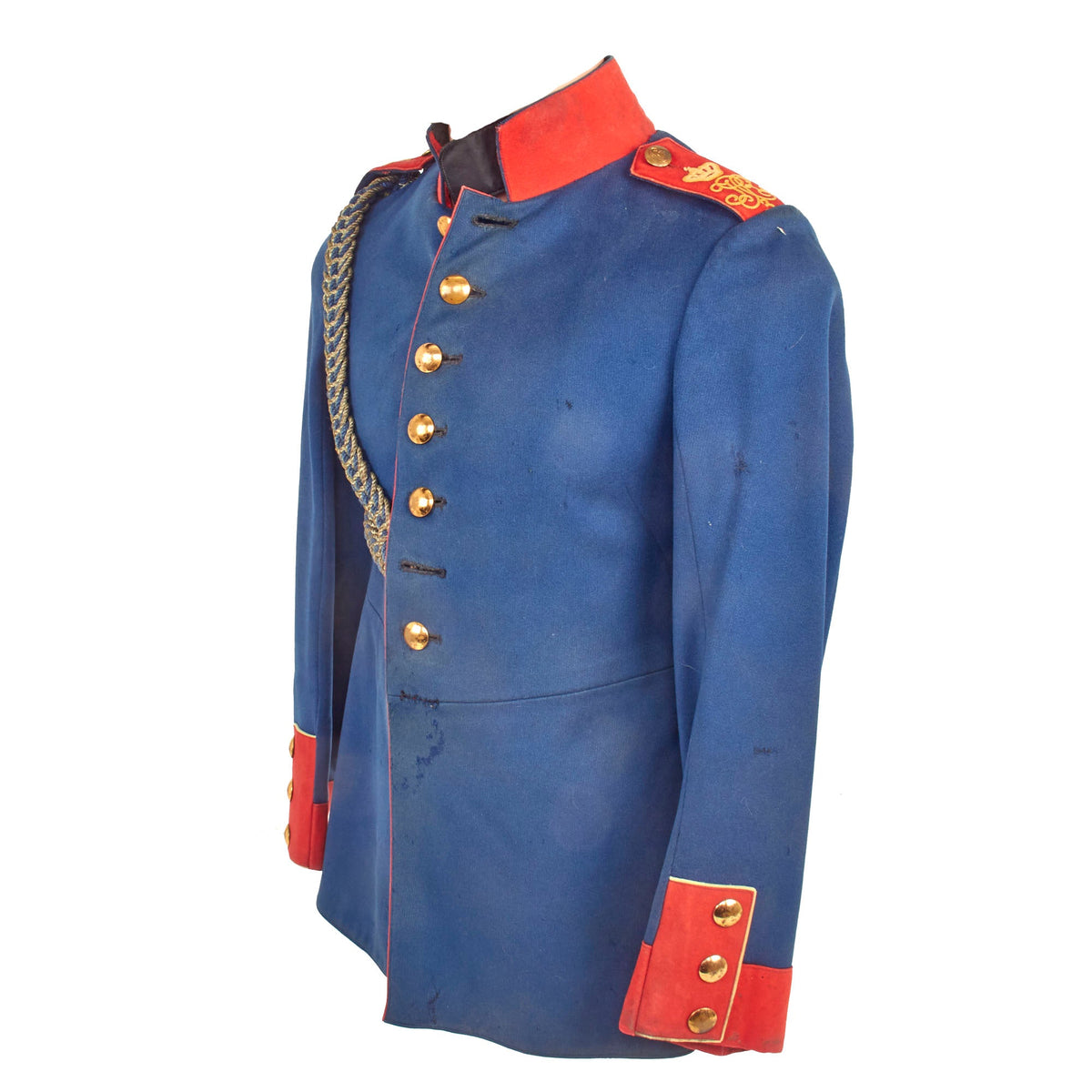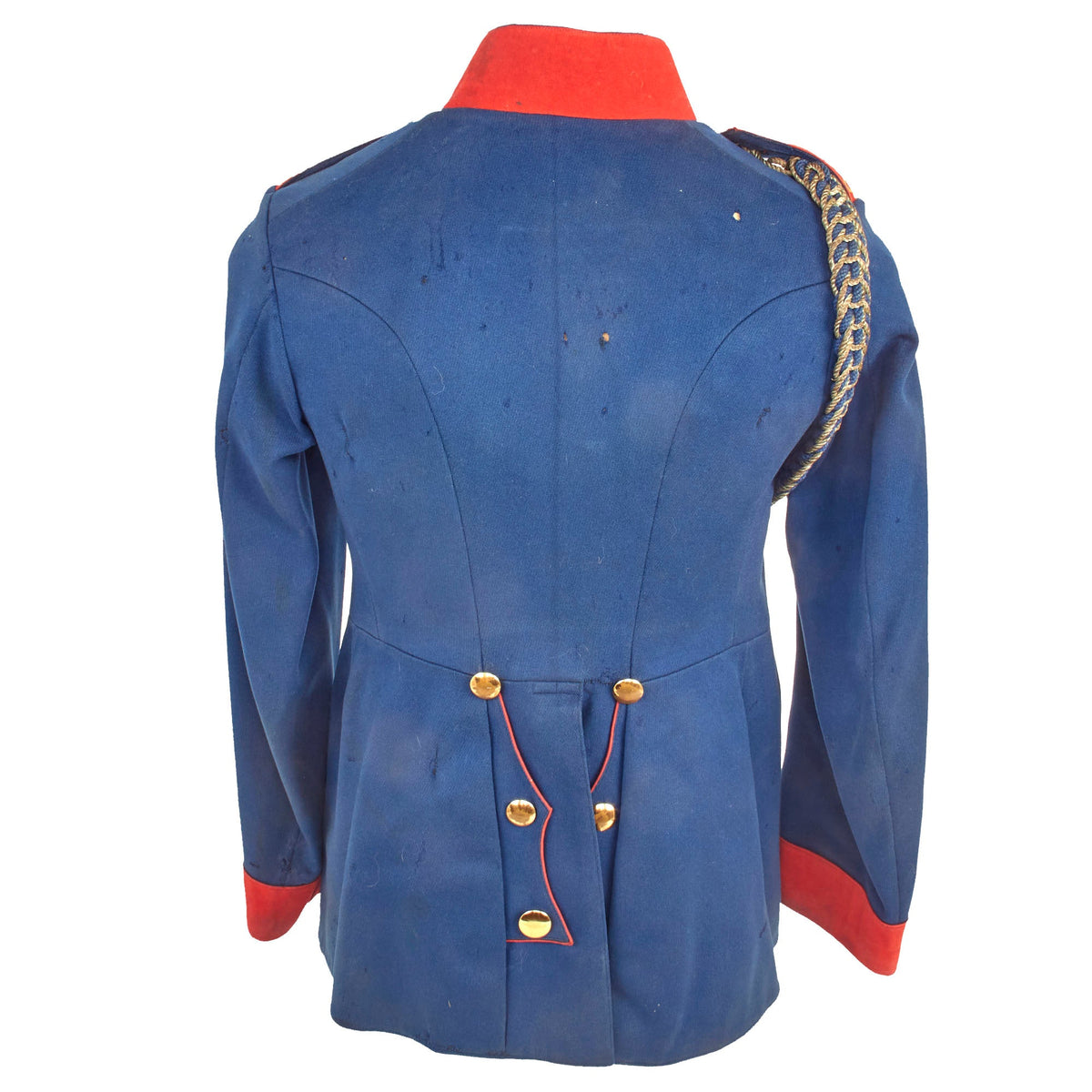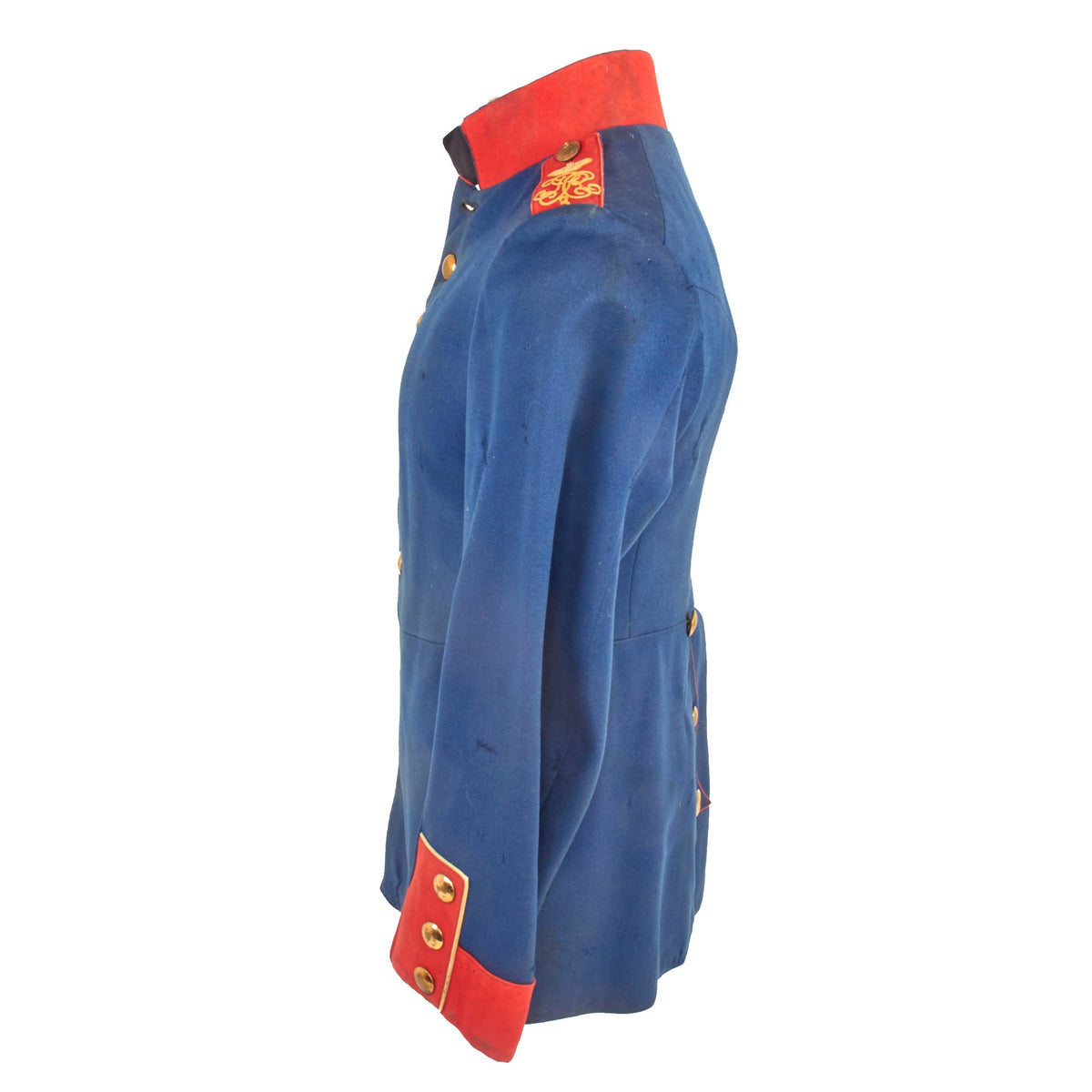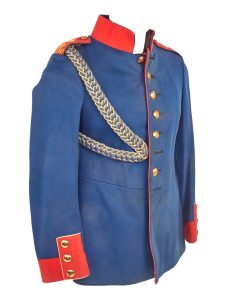Original German Pre-WWI Imperial German Royal Bavarian 3rd Infantry Regiment “Prinz Karl von Bayern” Dunkelblau Waffenrock Tunic Original Items
$ 550,00 $ 165,00
Original Item: Only One Available. This is a lovely M-1867 Waffenrock, featuring the beautiful Brandenburg Cuffs! In 1842, Preußen (Prussia) introduced a new pattern of uniform for all foot-troops consisting of a uniform called a Waffenrock to be worn with a tall leather spiked helmet called a Pickelhaube. This form of dress was considerably different from the short Kollet (a waist-length jacket with tails) worn with the high leather Tschako during the Napoleonic wars.
Dunkelblau (dark blue) Waffenrock were typically worn by Infantry, Feldartillerie (Field Artillery), Fußartillerie (Foot Artillery) Regiments, Train (Supply), Pionier (Pioneers) and most other units. Hellblau (light blue) Waffenrock were worn by the majority of Dragoner (Mounted Infantry) Regiments (except Hessen) while dark green Waffenrock were worn by Jäger (light Infantry) Battalions.
Issued Waffenrocks tend to be dark while Eigetumsstück (privately purchased) Waffenrocks are much lighter in color. Officer’s Waffenrock, when compared to an issued Waffenrock from the same unit, are considerably lighter in color as they were privately purchased. Conjointly, the lighter color was probably deemed “more fashionable” than the darker issued Waffenrocks of the men.
An AKO on 25 April 1895 announced the final refinements to the Waffenrock. The collar height on issue Waffenrock ranged from 4.5 to 5 cm, however, privately purchased Waffenrock invariably have higher collars ranging from 6 cm to 7 cm. Buttons were reduced in size from 25mm to 21mm. The rear skirt was given an actual vent on the M1895 Waffenrock, allowing the two rear skirt liner pockets to be accessed through a long vertical slit opening between the rear scallops. The color of the Waffenrock ranged from light to dark blue or green and the collar and cuffs came in a rainbow of colors as did the shoulder straps. The Waffenrock was to stay in this form until the eventual replacement by the M1907/10 Feldgrau Feldrock.
This M1867 has a lovely 1.5” standing collar, which is an indication of this being an issued one and not a private purchase. The color is the correct Dunkelblau and has red Brandenburg Cuffs. The Brandenburg cuff has a horizontal panel (usually red) around the circumference of the cuff, with a vertical panel superimposed on top. The vertical panel has three buttons. Both horizontal and vertical panels are often piped in the Army Corps color which in this case is white for infantry.
The shoulder straps bears the cipher “PRK 3” (Prinze Karl 3rd Infantry Regiment) with number 6 buttons for company/squad.
The overall condition is nice but there are some factors that affect the condition. There is minor separation in the collar as well as various new and old repairs done to the lining. All buttons are present and there is some deterioration to the inner lining, as well as staining, an indication of this uniform being worn. The back of the tunic does have holes and mothing present, but still displays well.
This is still a lovely example and not too many are left on the market! Comes ready to display!
Approximate Measurements
Collar to shoulder: 9.5″
Shoulder to sleeve: 24”
Shoulder to shoulder: 14.5”
Chest width: 17″
Waist width: 16″
Hip width: 19”
Front length: 30″
World War I
1914
At the beginning of the First World War in 1914, the regiment was mobilized and sent to the western front under the supreme command of the 6th Army. The first major battle took place near Saarburg on August 20th. Fighting on the border in Lorraine followed shortly thereafter, and from the end of September the first battle on the Somme.
1915
In 1915 the regiment came from the 2nd Infantry Division to the newly formed 11th Infantry Division and was transferred to the Eastern Front . There it was involved in the breakthrough at Gorlice-Tarnow in May 1915 , the capture of Przemyśl on June 3, 1915 and the subsequent month-long push back of the Russians ( Great Retreat ). The victorious campaign across the Danube through Serbia followed in the autumn .
1916
In the Battle of Verdun in spring 1916, the regiment fought at Avocourt. At the beginning of May 1916, Height 279 was finally conquered, where the regiment established itself for defence. After a terrible death toll in just under three months, the regiment was disbanded. In the summer of that year the regiment took part in repelling the Brusilov offensive in Volhynia . From autumn 1916 the regiment fought on the right (III Battalion) and left flank (I and II Battalions) of the 11th Infantry Division during the successful offensive through the Carpathian Mountains against Romania .
1917/18
In 1917 the association was transferred back to the western front, where it took part in the battles in Alsace , on the Aisne , in Flanders and in the German offensive in 1918.
The regiment, which was almost always deployed at the focal point of the fighting, lost more than 5,000 men through death between 1914 and 1918.
Fast Shipping with Professional Packaging
Thanks to our longstanding association with UPS FedEx DHL, and other major international carriers, we are able to provide a range of shipping options. Our warehouse staff is expertly trained and will wrap your products according to our exact and precise specifications. Prior to shipping, your goods will be thoroughly examined and securely secured. We ship to thousands clients each day across multiple countries. This shows how we're dedicated to be the largest retailer on the internet. Warehouses and distribution centres can be located throughout Europe as well as the USA.
Note: Orders with more than one item will be assigned a processing date depending on the item.
Before shipping before shipping, we'll conduct a thorough inspection of the items you have ordered. Today, the majority of orders will be delivered within 48 hours. The delivery time will be between 3-7 days.
Returns
The stock is dynamic and we cannot completely manage it because multiple stakeholders are involved, including our factory and warehouse. So the actual stock may alter at any time. It's possible that you may not receive your order once the order has been made.
Our policy is valid for a period of 30 days. If you don't receive the product within 30 days, we are not able to issue a refund or an exchange.
You can only return an item if it is unused and in the same state as the day you received it. You must have the item in its original packaging.
Related products
Uncategorized
Armored Burgonet Helmet & Polearm from Scottish Castle Leith Hall Circa 1700 Original Items
Uncategorized
Uncategorized
Uncategorized
Uncategorized
Uncategorized
Armoured Fighting Vehicles of the World: AFVs of World War One (Hardcover Book) New Made Items
Uncategorized
Uncategorized
Angolan Rebel 1970s era 60mm Inert Display Mortar from Angolan Civil War Original Items
Uncategorized
Uncategorized
Uncategorized
Uncategorized
Uncategorized
Uncategorized
Uncategorized
Uncategorized
